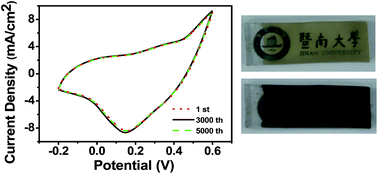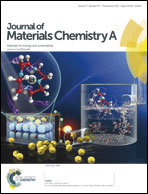Nickel oxide nanoflake-based bifunctional glass electrodes with superior cyclic stability for energy storage and electrochromic applications
Abstract
We report the fabrication of NiO nanoflake-based bifunctional glass electrodes that combine energy storage and electrochromism. We used conductive transparent glass as a current collector to replace conventional nickel foam and carbon cloth. Supercapacitor electrodes built from the NiO nanoflake films have high areal capacitance (74.8 mF cm−2 at a scan rate of 10 mV s−1), and excellent cyclic stability (almost unchanged after 5000 cycles). Moreover, the NiO nanoflake-based glass electrode changes from light brown to black with a large transmittance modulation of 40% and a high coloration efficiency (CE) of 63.2 cm2 C−1 at a wavelength of 632.8 nm, demonstrating its excellent electrochromic properties. The outstanding electrochemical and electrochromic performance is attributed to the porous morphology and strong adhesion to the glass of the nanoflake film. Our smart NiO-based glass electrode has superior cycle stability both in its electrochemical and electrochromic performance, revealing great potential for energy storage and electrochromic applications.


 Please wait while we load your content...
Please wait while we load your content...